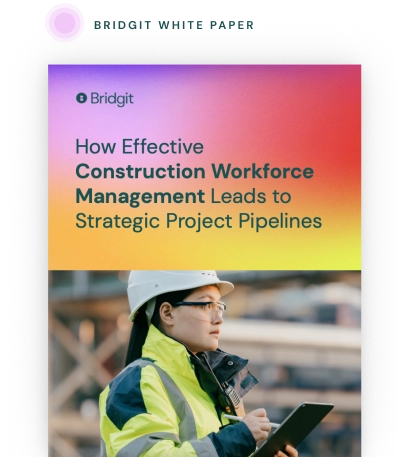Table of Contents
In my first year working in the construction software space, I talked to general contractors. My goal in those conversations was to understand their business, priorities, challenges, and how they resolve them. I’ve spoken to general contractors of every size, from those with a national presence and thousands of employees to GCs with five employees looking to establish their regional presence.
Even though every company is fundamentally unique, after so many conversations, I’ve noticed some common threads regarding technology adoption, the planning process, and putting your people first. In this article, I want to dive deeper into three trends I’ve seen:
- Lagging technology adoption isn’t a sign of inadequacy but a problem of complexity
- A constant tension between short-term and long-term thinking
- General contractors value their people
These trends point to the main problems the construction industry faces and how solutions are often embedded in those problems. By understanding these trends, you can extract insights to help you plan for 2023.
What I learned from conversations with general contractors
1. Lagging technology adoption is not your fault
Construction projects are complicated. General contractors are often tasked with solving some of the most complex problems humans face today. You must build custom buildings, data centers, factories, and infrastructure for unique clients with changing tastes, deal with ever-shifting deadlines, and manage vast workforces with specialty skills.
While the complexity is increasing, it’s no secret that the construction industry lags in technological adoption. Some may chalk that up to a lack of innovation and an aversion to technology due to being “old-school,” but from my experience, it isn’t fair to make that characterization. The reason for a lack of innovation comes from the scale of the construction industry’s challenges. Since the problems are so complex, the processes and the technology that improves those processes must be able to import that complexity and export it efficiently and user-friendly.
Think of it this way: It wasn’t until the last five years or so that computers had the processing power to capture, store, and crunch all the data associated with each project. That’s why we’re seeing such an influx of construction technology today. It’s not that the construction industry is lagging behind other industries; the technology is only now beginning to deliver the value general contractors need to warrant the adoption.
Simply put, you’re doing the best you can with the tools you have. Spreadsheets have helped move away from paper-driven processes, but more efficient and practical tools are on the rise. General contractors are willing to innovate as long as the implemented tool can handle the scale of the problem they must deal with.
As 2023 approaches, examining how your current tools are scaling with you is essential. Are they supporting your growth? Can they give you rich data so you can incrementally improve processes? Are they fostering collaboration or insulating data into silos? Is your team being used as effectively as possible?
Answering these questions thoroughly can help you decide to update your technology in lagging areas of your organization. A key thing to keep in mind when examining the technology is whether or not the software will simplify your company’s increasing complexity as it grows.

Use your workforce data to create a competitive advantage
Download our white paper to see how effective workforce planning can help stay ahead of labor demands and create a strategic project pipeline.
2. There is a tension between short-term and long-term thinking
I was recently speaking to the Vice President of a large construction company. I asked him how he manages his workforce and some challenges with planning it across their project pipeline.
He told me construction is an entirely reactive industry. Nothing is guaranteed. He even went as far as to say that planning long-term was impossible. Now, this was an exaggeration, considering his reputation and the longevity of his career. However, what stood out to me wasn’t his claims but the stress behind them. I had heard the same tone dozens of times before.
Many of the general contractors I’ve spoken to are constantly putting out fires threatening to derail a project. Problems like scheduling conflicts, labor shortages, unknown site conditions, or rising material costs can snowball and cause delays. If you multiply those issues across multiple projects over the years, the high stress and burnout experienced at the operational level will undoubtedly trickle down to your workforce. Your organization’s long-term vision and growth get clouded by the fires you have to fight today.
The goal of construction technology is to help general contractors balance short-term problems and long-term vision. This allows you to solve your day-to-day issues efficiently while also adhering to your company’s core long-term mission.
As an example, let’s use workforce planning, a process that historically has been very reactive. Bridgit Bench, our workforce management platform, was built to help contractors create that long-term and short-term balance. You can stay agile in the short term by easily making real-time adjustments to changes in your projects and workforce. You can also forecast in varying time increments to help you establish a long-term strategy and vision for your workforce.
Short-term planning is easier and more efficient, and long-term planning provides a map and directions for where you want your company to go. The tools you evaluate should give insight into both categories so you can make decisions without sacrificing any quality in your work.
3. General contractors care about people, a lot
Construction is for people by people. It isn’t just about erecting a building on a plot of soil. You are building places that people will live and work in. You’re setting the foundation for your communities.
The best GCs I’ve spoken with stress that people are the most critical resource in the industry. They want project stakeholders to be satisfied. They want their workforce to develop their skills, be proud of their work, and be proud of the organization they accomplished it with.
That said, the construction industry has reached a crossroads. According to Forbes, about 40% of the current U.S. construction workforce is set to retire in the next decade, and the current labor shortage is expected to expand in the next two years. Radical change is coming to the industry, and it’s directly tied to its most important resource: people.
General contractors must adapt to the changes in the industry landscape in new and creative ways. More and more GCs are addressing diversity and inclusion to attract employees. They’re also taking the time to prioritize and formalize day-to-day skill training and long-term career development to make sure that their people can better fulfill their career aspirations.
Additionally, GCs understand that implementing new technologies to improve processes will attract younger talent who’s already savvy enough to pick up and use new software and job-site tools easily.
At Bridgit, we understand that people are the cornerstone of the construction industry, and we know the sector will transform in the coming years. That’s why we created a tool to help you take a people-first approach to your workforce planning.
What is a people-first approach?
It’s using your workforce data to create better project teams, utilize your people efficiently, and proactively schedule in a way that supports your projects rather than hinders them.
Taking a people-first approach can help you prioritize and foster the collaboration needed to resolve the complex challenges you face while you plan for your future growth. To learn more about workforce planning, visit our blog. To learn more about Bridgit Bench, take a quick tour below. We’re always open to discussing your goals, your challenges, and how Bridgit can help.
Think your workforce planning meetings could be more productive?
Download our ebook to learn how to run efficient, effective workforce planning meetings with your team.



